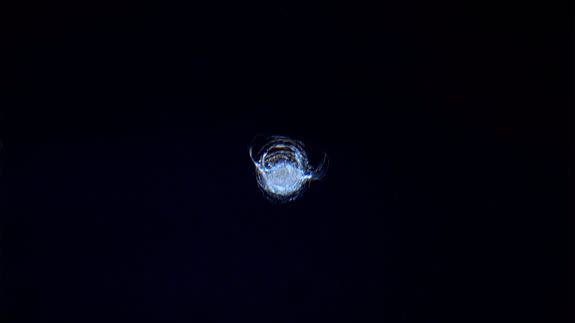A piece of space junk chipped one of the Space Station's huge windows

The image itself is innocuous looking: A circular dent in a window of the station's Cupola against the blackness of space.
But the photograph, which British astronaut Tim Peake took in April, points to a much larger threat that the International Space Station faces as it orbits the Earth every 90 minutes.
SEE ALSO: This graphic shows the massive growth of space junk orbiting Earth since 1957
The chip doesn't present an immediate threat to the astronauts and cosmonauts within the Space Station, and it doesn't stop crew members from taking photos of the incredible view provided by the massive Cupola windows.
But the small piece of space junk — which may have been a bit of fast-moving paint or metal a fraction of a millimeter in diameter, according to the European Space Agency (ESA) — represents the challenge of collisions with human-made debris in orbit.
"An object up to 1 cm in size could disable an instrument or a critical flight system on a satellite," the ESA said.
"Anything above 1 cm could penetrate the shields of the Station’s crew modules, and anything larger than 10 cm could shatter a satellite or spacecraft into pieces."
At the moment, there are millions of pieces of space debris swirling around in orbit at speeds of more than 17,000 mph.
The limits of tracking space junk
NASA keeps track of more than 500,000 of the biggest bits of space junk the size of a marble or larger, sometimes directing the Space Station to change its orbit slightly to keep out of the way of a particularly harmful piece of debris.
But there are millions of other pieces of debris too small to be tracked by space agencies around the world, including the small bit that hit the station's window.
Astronauts in space have also documented other evidence of small debris strikes on the Space Station.
Canadian astronaut Chris Hadfield tweeted a photo of a small hole in one of the orbiting outpost's solar panels, which was probably caused by a tiny bit of junk.
If Earth-orbit gets too clogged with junk from spent rocket bodies, satellites and other objects, it could pose a real risk for anyone hoping to get functioning spacecraft to space.
To mitigate those risks, scientists around the world are trying to develop technologies to either make spent satellites useful again or "clean up" the debris already floating around in orbit.
Some private spaceflight companies are also trying to do their part by producing reusable rockets that can fly back to Earth after launching a payload to orbit. There are still spent rocket bodies orbiting the planet whose orbits may not degrade for many decades.
The threat of space junk is also compounded by the fact that collisions between pieces of debris in orbit creates even more debris.
In 2007, Chinese officials fired a missile at a defunct weather satellite. That test alone produced more than 3,000 new pieces of junk, according to NASA.
In 2009, a spent Russian satellite impacted an operational commercial satellite, destroying it and producing 2,000 pieces of debris, the space agency added.
To prevent these kinds of debris encounters in the future, space agencies around the world have instituted guidelines to help mitigate the risks to future missions.
“These guidelines are applied to all new missions flown by ESA, and include dumping fuel tanks and discharging batteries at the end of a mission, to avoid explosions, and ensuring that satellites reenter the atmosphere and safely burn up within 25 years of the end of their working lives," Holger Krag, head of ESA’s space debris office, said in the statement.
